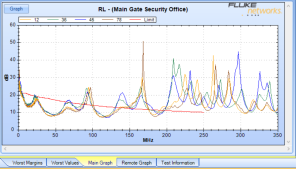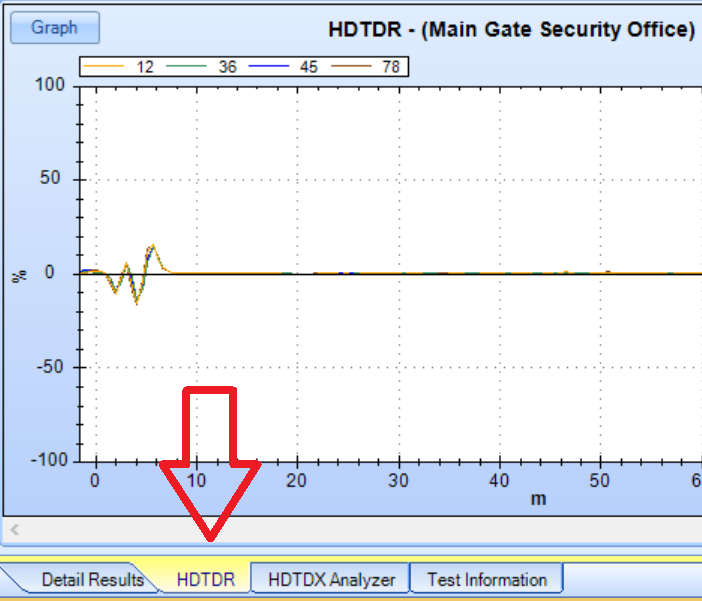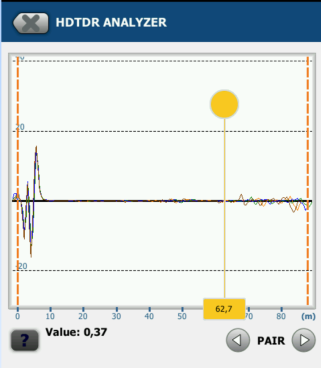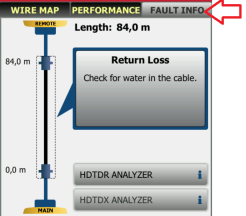Troubleshooting Installed Cable with DSX-5000 CableAnalyzer
August 2, 2018 / General, Upgrading and troubleshooting, Best Practices
It felt like a Monday morning when the call, actually an e-mail, came in. “I think my DSX is broken!” As you know, they are really tough machines and, when it looks like the Fluke is wrong, usually it isn’t.
“What makes you think it is broken?” I asked, “How does this failure manifest itself?”
“The tester is failing links that used to pass.”
I had the customer send me the .flw file, the detailed test results, this is always an important first step in the troubleshooting process. There is a lot of information in those files and it gives us pretty detailed information about the links.
Looking at the file, it was clear there was a failure, in the Return Loss parameter:


This is a very distinct Return Loss graph, and I recognized what the problem was right away, but let me walk you through how we figure this out.
One of the first things we do is to check if the unit has the most recent firmware, it does:

The next step is to look at which parameters failed, in this case, Return Loss. Return Loss is a measurement of reflected signals. The can really screw up full duplex communications like Gigabit Ethernet as the reflected signals can be confused with the signals transmitted from the far end, causing physical layer errors like CRC or FCS errors. This makes the network seem slow, because of retransmissions, or, it can screw up the quality of voice and video due to lost packets. Here is the graph of the Return Loss performance. Is shows the strength of the reflected signal, or noise, on the vertical axis and the frequency on the horizontal axis:

The challenge here is that the standard requires us to report this in the Frequency Domain as opposed to the Time Domain. I can tell that we are failing at lower frequencies, between say 10 and 200 MHz, but I don’t know the distance to where this is happening.
The DSX-5000, like the earlier Fluke Networks Cable Analyzers, has a useful feature where we can look at Return Loss in the time domain with our HDTDR, High Definition Time Domain Reflectometer. Here is that graph for this cable, and on it, we can see the problem starts at a very short distance from the beginning of the cable:

Here’s what it looks like on the tester:

It still takes a trained eye to see what is going on in this graph, but knowing the distance to the problem is often half the battle. If you know where to go, you have a pretty good chance of knowing what is going wrong and what to fix. Very helpful to know, for example, that you need to re-terminate the jack as opposed to the patch panel, or vice versa.
The DSX goes a step further though in the trouble-shooting process. We have an on-board “expert” that can take a look at the failure and, most of the time, provide a clear answer to what is happening. In this case, it told me this:

Armed with this information, I gave the customer a call and asked, “Is this cable installed in a buried conduit?”
From the silence on the other end I knew I had hit the nail on the head.
When the cable had been installed, the conduit was dry, but over time, that changed. So their DSX-5000 was working just fine – maybe more than just fine! On a side note, CM and CMR rated cables are not designed for use outdoors.
HDTDR works well to show the distance to Return Loss failures, and we use HDTDX to find the distance to NEXT, or Cross-Talk failures. Fault info has been improved in the DSX, taking 20 years of trouble shooting experience and programming it into the testers.
 Jim Davis has been working in the cabling industry for over 20 years. For the last 17 years he has worked at Fluke Networks, first as the Sales Director for Latin America, and more recently as a Regional Marketing Engineer. Jim has worked on International Cabling Standards Committees and is a frequent speaker at trade shows such as Bicsi and Netcomm and manufacturer’s conferences such as Panduit, Furukawa, CommScope, Belden and many others. Jim’s objective is to bring the experience of the Industry, the Market and the Lab to you and present it in way that the common user can understand.
Jim Davis has been working in the cabling industry for over 20 years. For the last 17 years he has worked at Fluke Networks, first as the Sales Director for Latin America, and more recently as a Regional Marketing Engineer. Jim has worked on International Cabling Standards Committees and is a frequent speaker at trade shows such as Bicsi and Netcomm and manufacturer’s conferences such as Panduit, Furukawa, CommScope, Belden and many others. Jim’s objective is to bring the experience of the Industry, the Market and the Lab to you and present it in way that the common user can understand.




